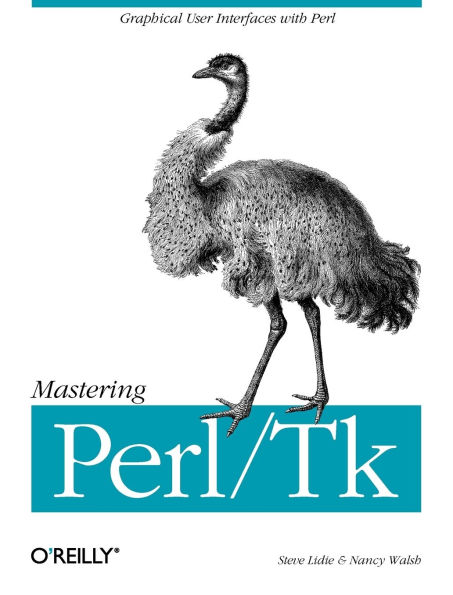Mastering Perl/Tk: Graphical User Interfaces in Perl
Perl/Tk is the marriage of the Tk graphical toolkit with Perl, the powerful programming language used primarily for system administration, web programming, and database manipulation. With Perl/Tk, you can build Perl programs with an attractive, intuitive GUI interface with all the power of Perl behind it. Mastering Perl/Tk is the "bible" of Perl/Tk: It's not only a great book for getting started, but the best reference for learning the techniques of experienced Perl/Tk programmers. The first half of the book contains the basics on how to use Perl/Tk, and then branches out into advanced applications with a series of extensive program examples. The result is a book accessible for novices, and invaluable for experienced programmers ready to learn the next step in the elegant and effective use of Perl/Tk. The book includes:
1124402049
- An introduction to each of the basic Perl/Tk widgets and geometry managers
- A dissection of the MainLoop, including how to use callbacks and bindings effectively
- Coverage of the Tix widgets, an extended set of widgets that are a part of the standard Perl/Tk distribution
- Working with images in Perl/Tk, including bitmaps, pixmaps, photos, and how to compose a compound image type
- How to create custom mega-widgets in Perl/Tk, both composite and derived
- Handling interprocess communication with Perl/Tk, both with standard Unix utilities (pipes and sockets) and with the send command designed for direct communication between Tk applications
- Developing your own Tk widget in the C language
- Examples of web applications written with Perl/Tk and the LWP library
Mastering Perl/Tk: Graphical User Interfaces in Perl
Perl/Tk is the marriage of the Tk graphical toolkit with Perl, the powerful programming language used primarily for system administration, web programming, and database manipulation. With Perl/Tk, you can build Perl programs with an attractive, intuitive GUI interface with all the power of Perl behind it. Mastering Perl/Tk is the "bible" of Perl/Tk: It's not only a great book for getting started, but the best reference for learning the techniques of experienced Perl/Tk programmers. The first half of the book contains the basics on how to use Perl/Tk, and then branches out into advanced applications with a series of extensive program examples. The result is a book accessible for novices, and invaluable for experienced programmers ready to learn the next step in the elegant and effective use of Perl/Tk. The book includes:
- An introduction to each of the basic Perl/Tk widgets and geometry managers
- A dissection of the MainLoop, including how to use callbacks and bindings effectively
- Coverage of the Tix widgets, an extended set of widgets that are a part of the standard Perl/Tk distribution
- Working with images in Perl/Tk, including bitmaps, pixmaps, photos, and how to compose a compound image type
- How to create custom mega-widgets in Perl/Tk, both composite and derived
- Handling interprocess communication with Perl/Tk, both with standard Unix utilities (pipes and sockets) and with the send command designed for direct communication between Tk applications
- Developing your own Tk widget in the C language
- Examples of web applications written with Perl/Tk and the LWP library
49.99
In Stock
5
1

Mastering Perl/Tk: Graphical User Interfaces in Perl
768
Mastering Perl/Tk: Graphical User Interfaces in Perl
768
49.99
In Stock

Product Details
| ISBN-13: | 9781565927162 |
|---|---|
| Publisher: | O'Reilly Media, Incorporated |
| Publication date: | 12/01/2001 |
| Pages: | 768 |
| Product dimensions: | 7.00(w) x 9.19(h) x 1.70(d) |
About the Author
From the B&N Reads Blog
